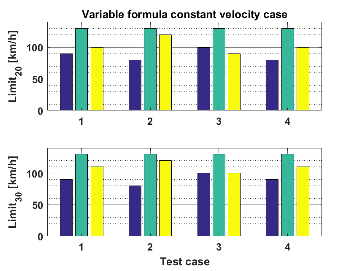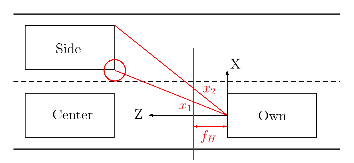




Did you find this useful? Give us your feedback
















30 citations
...While the seat-integrated techniques (ECG, cECG and BCG) have been used extensively in the automotive environment [121]; camera-based techniques, although not studied at a high level of readiness to the same extent as seat-integrated techniques, also remained popular [122,123]....
[...]
8 citations
...The braking model for the own vehicle is the same as in [7] considering the hardware delay (0....
[...]
...Mono camera-based distance estimation is relatively easy for static obstacles as for example [3] and the authors’ previous work [7] show....
[...]
306 citations
...Scale change of the obstacle image and system sampling time are considered in [6] and [9] to estimate time to collision (TTC)....
[...]
...The authors target to compare existing mono camera-based methods without radar assistance as this is an extensively researched field in automotive ([2],[3],[4],[5],[6],[7],[8],[9]) and a good opportunity to evaluate their mono camera-based obstacle avoidance algorithm ([10],[11]) used in aerospace until now....
[...]
263 citations
...Point of contact of the vehicle with ground and known camera height are considered in [2], [12] from which the range can be directly obtained and again the size and side distance....
[...]
...The authors target to compare existing mono camera-based methods without radar assistance as this is an extensively researched field in automotive ([2],[3],[4],[5],[6],[7],[8],[9]) and a good opportunity to evaluate their mono camera-based obstacle avoidance algorithm ([10],[11]) used in aerospace until now....
[...]
239 citations
...A braking model is set up in [14] giving the jerk as aa = −20m/s(3) and the brake system delay as t2 = 0....
[...]
60 citations
...Scale change and traveled distance are considered in [8] from which the range and again the size and side distance can be determined....
[...]
...The authors target to compare existing mono camera-based methods without radar assistance as this is an extensively researched field in automotive ([2],[3],[4],[5],[6],[7],[8],[9]) and a good opportunity to evaluate their mono camera-based obstacle avoidance algorithm ([10],[11]) used in aerospace until now....
[...]
53 citations
...The braking model in [15] was modified to have three parts: distance traveled during system delay...
[...]
...A more detailed braking model is used in [15] as: S = (t1 + t2 + 0....
[...]
The first contribution of the paper is to extend the methods to consider N data points and variable velocity, however only three methods could be extended for variable velocity. Future work should include closed form sensitivity analysis of the methods to underline these results, consideration of measurement errors regarding velocity and vehicle position and the extension of the methods for moving obstacle if possible.
The added longitudinal velocity disturbance is: ∆Vz = 1.34 sin ( 2π T + π 2 ) [m/s] with T = 3sec period time whilethe lateral is: ∆Vx = 0.4 sin ( 2π T + π 2 ) [m/s].
The evaluation criteria was the hitting speed of the obstacle (if the emergency braking does not stop completely the own vehicle because of estimation errors) and the precision of side distance and size estimation.
pitch or yaw angle sinusoidal disturbances were applied to test the camera angular alignment sensitivity of the methods.
The applicability limits of the own method are 90km/h for 20km/h and 100km/h for 30km/h hitting speed limit with the constant velocity formulas, which decreases to 70km/h and 90km/h in the variable speed cases respectively.
The braking model in [16] was modified to have three parts: distance traveled during system delay S2 = V0t2, distance traveled until deceleration builds up S3 = V0t3 + aa t33 6 and distance traveled during constant deceleration S4 = V3t4 +ax t24 2 .
the case of time-varying velocity can not be included into this framework as it does not comply with TTC estimation.
The overall conclusion form the test campaign is that the own SAA method is the most reliable considering also the attitude disturbances which are inevitable with vehicles and even a good attitude compensation system can left 1◦ error in the parameters.
the side distance can be calculated as X0 = CPA ·WFirst, the applicability of the constant velocity formulas was tested simulating constant vehicle speed.
Future work should include closed form sensitivity analysis of the methods to underline these results, consideration of measurement errors regarding velocity and vehicle position and the extension of the methods for moving obstacle if possible.
The considered vehicle widths in lane design are 1.75m for car and 2.55m for truck as shown in [14] and a typical lane width can be 3m.
The basic formulas relate forward (Z) and side distances (X) and the object size (W) to the measurable image parameters (x,S):1Sk = Zk fHW , xk Sk = Xk W(11)Considering Vx = 0 side velocity (Xk = X0 = const), Vz < 0 forward velocity and the camera projection model in Fig. 1:1 Sk = − Vz fHW TTCk = Vz fHW︸ ︷︷ ︸ a tk − Vz fHW tC︸ ︷︷ ︸ b xk Sk = CPA(12)The first expression gives a possibility to fit line on the points 1/Sk, tk and so obtain the absolute time of collision as tC = −b/a and ˆTTCk = tC − tk.
Another test was the evaluation of variable speed formulas with ramp up (20 to 130km/h) or down (130 to 20km/h) vehicle speed profile reaching the end value at the obstacle.